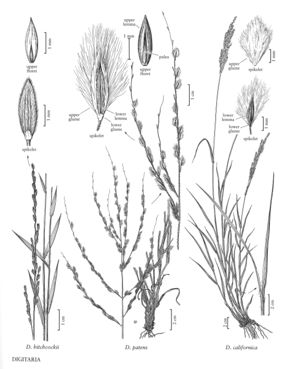Digitaria patens
Plants perennial; cespitose, neither rhizomatous nor stoloniferous. Culms 40-90 cm, erect, sometimes geniculate, not rooting, at the lower nodes. Leaves mainly cauline; basal sheaths villous; upper sheaths glabrous or sparsely to densely hirsute, hairs papillose-based; ligules (1) 1.5-4 mm, entire to lacerate; blades 5-15 cm long, 1-4 mm wide, glabrous or sparsely pubescent. Panicles with 4-10 spikelike primary branches on (4) 10-18 cm rachises; primary branches 4-10 cm, usually divergent at maturity, varying to ascending, axes not wing-margined, bearing spikelets in unequally pedicellate pairs; internodes (4.5) 6-15 mm (midbranch); secondary branches rarely present; shorter pedicels 2-2.5 mm; longer pedicels 7-8 mm; terminal pedicels of primary branches 7.4-20 mm. Spikelets homomorphic, 3.7-5.8 mm (including pubescence), 2.9-4.3 mm (excluding pubescence). Lower glumes 0.3-0.5 mm; upper glumes 2.4-3.5 mm (excluding pubescence), 3-veined, densely villous, hairs 1.5-4 mm, silvery-white to purple, spreading at maturity; lower lemmas 2.8-4.2 mm (excluding pubescence), exceeding the upper lemmas by 0.8-2.2 mm, 5-veined and the veins equally spaced or 7-veined and the lateral-veins closer to each other than to the central vein, margins densely villous, hairs 1.5-4 mm, silvery-white to purple, spreading at maturity, apices acuminate; upper lemmas 2.6-3.2 mm, lanceolate, brown when immature, dark-brown at maturity, acuminate. 2n = 72.
Discussion
Digitaria patens is endemic to southwestern and southern Texas and adjacent Mexico. It grows in well-drained, usually sandy, soils, often in disturbed habitats. Gould (1975) suggested that it might be an octoploid derivative of D. californica.
Selected References
None.
Lower Taxa
"decumbent" is not a number.
